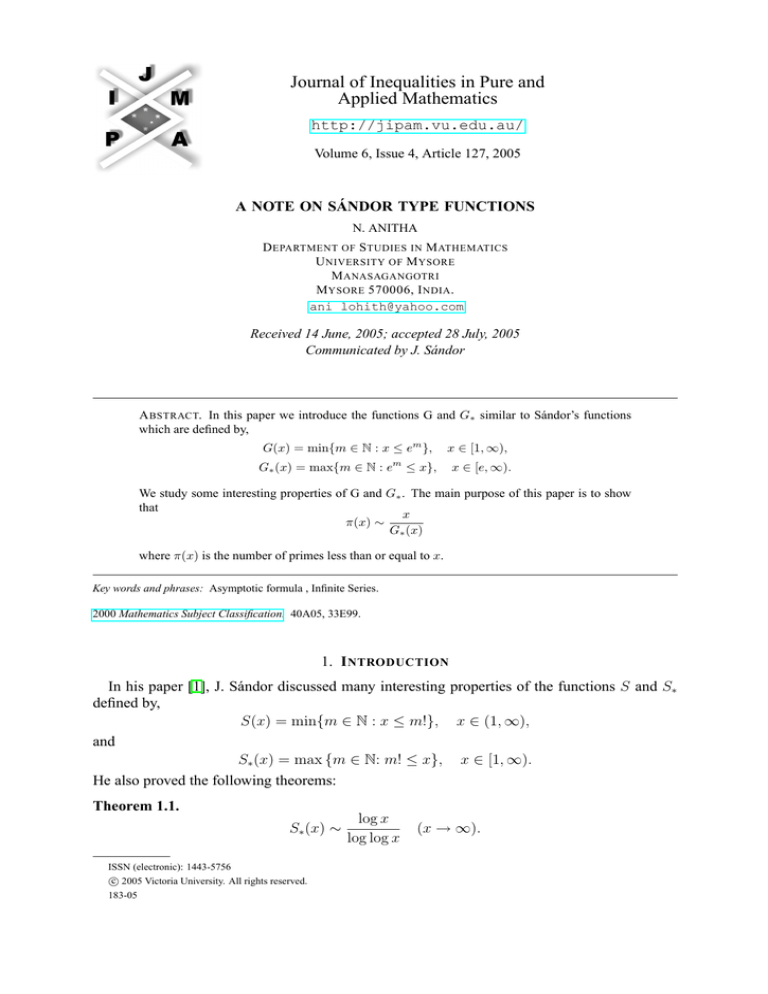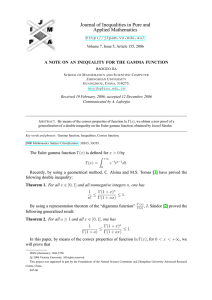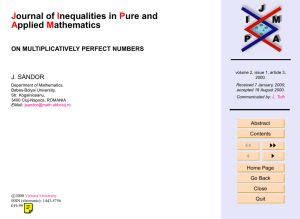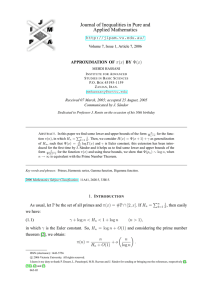
Journal of Inequalities in Pure and
Applied Mathematics
http://jipam.vu.edu.au/
Volume 6, Issue 4, Article 127, 2005
A NOTE ON SÁNDOR TYPE FUNCTIONS
N. ANITHA
D EPARTMENT OF S TUDIES IN M ATHEMATICS
U NIVERSITY OF M YSORE
M ANASAGANGOTRI
M YSORE 570006, I NDIA .
ani_lohith@yahoo.com
Received 14 June, 2005; accepted 28 July, 2005
Communicated by J. Sándor
A BSTRACT. In this paper we introduce the functions G and G∗ similar to Sándor’s functions
which are defined by,
G(x) = min{m ∈ N : x ≤ em },
m
G∗ (x) = max{m ∈ N : e
x ∈ [1, ∞),
≤ x},
x ∈ [e, ∞).
We study some interesting properties of G and G∗ . The main purpose of this paper is to show
that
x
π(x) ∼
G∗ (x)
where π(x) is the number of primes less than or equal to x.
Key words and phrases: Asymptotic formula , Infinite Series.
2000 Mathematics Subject Classification. 40A05, 33E99.
1. I NTRODUCTION
In his paper [1], J. Sándor discussed many interesting properties of the functions S and S∗
defined by,
S(x) = min{m ∈ N : x ≤ m!}, x ∈ (1, ∞),
and
S∗ (x) = max {m ∈ N: m! ≤ x}, x ∈ [1, ∞).
He also proved the following theorems:
Theorem 1.1.
S∗ (x) ∼
ISSN (electronic): 1443-5756
c 2005 Victoria University. All rights reserved.
183-05
log x
log log x
(x → ∞).
2
N. A NITHA
Theorem 1.2. The series
∞
X
n=1
1
n[S∗ (n)]α
is convergent for α > 1 and divergent for α ≤ 1.
Now we will define functions G(x) and G∗ (x) and discuss their properties. The functions are
defined as follows:
G(x) = min{m ∈ N : x ≤ em }, x ∈ [1, ∞),
G∗ (x) = max{m ∈ N : em ≤ x}, x ∈ [e, ∞).
Clearly,
G(x) = m + 1, if x ∈ [em , em+1 ) for m ≥ 0.
Similarly,
G∗ (x) = m, if x ∈ [em , em+1 ) for m ≥ 1.
It is immediate that
(
G∗ (x) + 1, if x ∈ [ek , ek+1 ) (k ≥ 1)
G(x) =
G∗ (x),
if x = ek+1 (k ≥ 1).
Therefore,
G∗ (x) + 1 ≥ G(x) ≥ G∗ (x).
It can be easily verified that the function G∗ (x) satisfies the following properties:
(1) G∗ (x) is surjective and an increasing function.
(2) G∗ (x) is continuous for all x ∈ (e, ∞)\A, where A = ek , k ≥ 1 and since limx%ek G∗ (x) =
k, limx&ek G∗ (x) = k − 1 for k ≥ 1, G∗ (x) is continuous from the right at x = ek (k ≥
1), but it is not continuous from the left.
(3) G∗ (x) is differentiable on [e, ∞) \ A, and since
lim
x&ek
G∗ (x) − G∗ (ek )
= 0,
x − (ek )
it has a right derivative at ek .
(4) G∗ (x) is Reimann integtrable over [a, b] ⊂ R for all a ≤ b.
Also
Z el
l−k
X
G∗ (x)dx = (e − 1)
(ek + m − 1)(k + m − 1).
ek
m=1
2. M AIN R ESULT
The main purpose of this paper is to prove the following theorem:
Theorem 2.1.
π(x) ∼
x
.
G∗ (x)
Proof. To prove our theorem first we will prove that
(2.1)
G∗ (x) ∼ log x.
By Stiriling’s formula [2] we have
n! ∼ ce−n nn+1/2
i.e.,
en ∼
J. Inequal. Pure and Appl. Math., 6(4) Art. 127, 2005
cnn+1/2
n!
http://jipam.vu.edu.au/
A N OTE ON S ÁNDOR T YPE F UNCTIONS
3
Thus,
n
log e ∼ log
and hence,
n∼n+
cnn+1/2
n!
1
log n + log c − log n!.
2
Also we have,
log(n!) ∼ n log n ⇒ n ∼ log n
(cf. [1], Lemma 2 ).
If x ≥ e then x ∈ [en , en+1 ) for some n ≥ 1.
Since G∗ (x) = n if x ∈ [en , en+1 ), n ≥ 1, we have
n
G∗ (x)
n
≤
≤ .
n+1
log x
n
As
n
lim
= 1,
n→∞ n + 1
we have
G∗ (x) ∼ log x.
From the prime number theorem it follows that
x
π(x) ∼
.
G∗ (x)
3. R EMARK
The following table compares the values of π(x) and
x
π(x)
x
:
G∗ (x)
x
G∗ (x)
10
5
3.3333
100
26
20.00000
1000
169
142.857143
10000
1230
1000
100000
9593
8333.3333
1000000 78499 71428.571429
10000000 664580 588235.294118
Now we prove the following theorem which is similar to Theorem 1.2.
Theorem 3.1. The series
∞
X
n=1
1
n[G∗ (n)]α
is convergent for α > 1 and divergent for α ≤ 1.
Proof. By (2.1) we have
A log n ≤ G∗ (n) ≤ B log n
where (A, B ≥ 0) for n ≥ 1.
Therefore it is sufficient to study the convergence of the series
∞
X
1
.
α
n(log
n)
n=1
To study the convergence of the above series we use the following result:
J. Inequal. Pure and Appl. Math., 6(4) Art. 127, 2005
http://jipam.vu.edu.au/
4
N. A NITHA
If φ(x) is positive for all positive ‘x’ and if
lim φ(x) = 0
x→∞
then the two infinite series
∞
X
φ(n) and
n=1
∞
X
an φ(an )
n=1
behave alike for any positive integer ‘a’.
Therefore the two series
∞
X
1
and
α
n(log
n)
n=1
∞
X
n=1
an
(an )[log (an )]α
behave alike.
However, the second series converges for α > 1 and diverges for α ≤ 1. Hence the theorem
is proved.
R EFERENCES
[1] J. SÁNDOR, On an additive analogue of the function S, Notes Numb. Th. Discr. Math., 7(2) (2001),
91–95.
[2] W. RUDIN, Principles of Mathematical Analysis, Third ed., Mc Graw-Hill Co., Japan, 1976.
J. Inequal. Pure and Appl. Math., 6(4) Art. 127, 2005
http://jipam.vu.edu.au/








